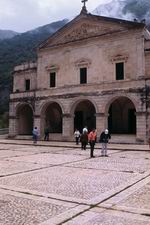| |||||
 |
Abbeys, churches and sanctuaries in Ciociaria | ||||
| During the pagan era Ciociaria was covered all over by temples and then, with Christianity, beautiful churches and shrines were built. | |||||
| Related images (2) |
|
THE ABBEY OF MONTECASSINO
Cassino's monks practiced medicine, music, astronomy, law, philosophical sciences and translated from Latin and Greek the works of the past; in the monastery's library is kept the placito cassinese, the first legal document written in vulgar Italian. Nortwithstanding the four disastrous destructions undegone, Montecassino is still there 'where it was, as it was', as announced by Abbot Ildefonso Rea. The abbey, as we see it today, is a perfect reconstruction of the structure existing before the bombings of the second world war which razed it virtually to the ground. You enter the monastery through three large Renaissance cloisters that lead to the church. Of the three entrance portals, only the central one is the original. It is a 12th-century Byzantine work bearing an inscription in geminated letters listing all the lands possessed by the abbey. The two lateral doorways, a work by Canonica in 1952, recall important episodes of the life of St Benedict in Montecassino, whereas in the lower part are depicted the four destructions undergone by the monastery (in 581, 883, 1349, 1944). The austere front is in contrast with the gorgeous polycromy of the precious marbles and gilded stuccoes which decorate the church; the vaults, once painted by Luca Giordanohave been partly redecorated with frescoes by the contemporary painter P. Annigoni, whereas 17th/18th-century paintings of Neapolitan school have been placed on the altars. Under the altar, a captivating crypt shelters the mortals remains of St. Benedict and his sister St Scolastica. For a better knwledge of the important role played by Montecassino in the history of culture, it is advisable to visit the Museum, where are gathered the illuminated manuscripts parchments and literary texts that made Montecassino a beacon of culture for many years.
THE ABBEY OF CASAMARI The Abbey of Casamari, in Veroli, rises majestically on the remains of Ceretae Marianae, an ancient Roman Municipium, where the famous Roman commander Caius Marius was born. Destroyed by the barbarian invasions, the place stood there abondoned until 1096, when four Benedictine monks built the first settlement which was later enlarged. In the 13th century, it was entrusted to the Cistercians, a new monastic order held in great esteem by the popes of that time. In 1203, the Cistercian monks, following the preaching of St Bernard, built a big but simple church in Gothic-Cistercian style, avoiding extra decorations and aiming at a pure architecture style. The building of the church, devoted to the Virgin Assumption together with the saints John and Paul, began under the auspices of Innocent III and it was consacreted in 1217 by Pope Onorio III. The interior, extremely austere, is divided in three naves and has a square apse and a transept with six chapels; in the middle there is a big Baroque ciborium, a gift by Clemente XI in 1711. This abbes is one of the few models that still has the special organization planned by Bernardo di Chiaravalle. The church, as the main body, is set on the north so that the rest of the monastery is sheltered from the north wind; the Cloister, a place where monks pray, meet and walk, has fine mullioned windows, finely decorated, and it leads to the Chapter Hall, the Refectory, the fields and the workshops. Within this large monastic complex, there are also a Library, a Museum wtih a Painting Gallery, where are kept Roman furniture, as well as paintings by the artists Carassi, Guercino, Sassoferrato, Serodine, Balbi, Purificato and Fantuzzi.
THE CHARTERHOUSE OF TRISULTI Set against one of the most breath-taking landscapes of Ciociaria, at an altitude of 800m, the Charterhouse of Trisulti is a splendid monastic complex that has now become a national monument. After the first Benedectine settlement, founded thanks to the initiative of San Domenico da Foligno and lasted around two years, in 1204 the monastery was entrusted by the will of Innocent III to the Carthusian monks, who held it until the end of the second world war, when it was handed over to the Cistercian monks. The complex is accessible through and entrance portal, decorated with a bas-relief depicting Saint Batholomew, the protector of the Cathusian, monks whereas on the second span the painter Filippo Balbi painted a Madonna offering some bread to a monk. Then you reach the main square where are the medieval facade of the Palace of Innocent III which today is the seat of an important Library, and the neoclassical front of the Church devoted to the Virgin Assumption, Saints Bartholomew and Bruno, founder of the Carthusian order. This Church, with a chamber plant, is divided into two sectors by a jube, on whose sides two altars shelters the mortal remains of two martyr saints, namely Boniface and Benedict; high up on both sides of the wall, there are some fine paintings by F. Balbi, whereas at the bottom is placed a choir of the lay brothers, a work by local wood-carvers dating from the end of the 17th century. As you walk through the door that divides the space once reserved to the choir brothers, you can admire a finelly carved chancel with rich engravings and animal figures, made by the sculptor Jacobò at the end of the 16th century. The church walls are covered by fine paintings by Balbi and Battelli, whereas the large frescoe on the vault depicting the Glory of the Blessed and Saints is by Caci (1683). The fame of this monastery is partly due to the presence of a beautiful pharmacy, frescoed by the painter G, Manco with Pompey's themes and decorated by artistic glass-cases, stills showing the glass containers that held the remedies. In front of it, a sitting-room decorated by F. Balbi, served once as a guest-room.
CATHEDRALS AND CHURCHES 'Great and solemn country pagan and Catholic...', so Carducci describes Ciociaria, a land that even during paganism was full of temples and imbued with sacredness. On the tops of the most important cities people built the Acropolis sacred to Saturn; on the gates of the polygonal walls, phallic symbols were sculptured to protect people and to invoke the goodwill of the gods, to whom fertility was asked; in the woods, by the sacred springs, lambs were sacrified at 'Ver Sacrum'. When paganism ceased to win followers, Ciociaria, where by now some apostles and devout women had arrived, saw the dawn of a new day, announced by the mountain hermitages and in the proto-coenobies from which came out the preaching of the Benedectine monasticism. On the hill tops new buildings appeared and on the temples' ruins, some of the most beautiful Churches and Abbeys of this land were built, a land that still today lives its faith with deep spiritual fervour.
ANAGNI'S CATHEDRAL As a superb medieval masterpiece of architecture, the Cathedral of Anagni is an elegant and balanced mixture between the Romanesque and the Lombard styles. On the severe main facade, in Campania's Romanesque style, three portals open up, the central which is surmounted by a classic decoration with some Byzantine influences. The back fron is more decorated and shows clear evidence of the influences of the Romanesque-Lombard style with three fine apses, surmounted by a series of small columns holding small arches with finelly decorated friezes. Detached from the body of the church, there is a massive bell tower with five rows of mullioned openings with one, two or three lights. The church interior offers interesting features; in the 13th centuries it was embellished with a multi-coloured mosaic floor, a work by the Cosmatesque craftsmen, whereas in the transept area there are a fine iconostasis, a Bishop's chair and a Paschal candle made by the Vassalletto. On the right lateral nave in line with the transept there is the entrance of the Crypt, a real treasure of this church. Thanks to the picture quality and the complexity of the themes of the frescoes covering its walls, it has been considered as one of the most important painting cycles of medieval art. From the same nave you can enter a Museum containing inscribed stone slabs or tablets and the Treasure Museum, which gathers sacred vestments and objects used for the rites dating from the 12th/13th centuries.
SANTA MARIA SALOME'S BASILICA – VEROLI This Basilica, devoted to Santa Salome, patron saint and protector of Veroli, was built in 1209, when, according to the medieval chronicles, the remains of a pious woman said to have witnessed Christ's Calvary were found. Although some violent earthquakes partly destroyed the first medieval oratory, Veroli's people never stopped the worshipping of the Saint and never gave up the thought of rebuilding her temple. The present church is the result of restoration works carried out in 1700 at the request of the Bishops de' Zaulis and Tartagni. The interior, divided into three naves, is full of fine paintings and frescoes attributed to the Cavalier d'Arpino, to F. Solimena, G. Passeri and G. Brandi, well-known representatives of Manneristic and Baroque painting. Few but interesting traces are left of the first medieval church: there are some 13th/15th century frescoes on the left wall of the transpet and in the underlying oratory whose entrance is on the right nave. Particularly interesting is the Confession, where are kept the mortal reamins of Santa Salome who left in Veroli a fragment of Christ's Cross walled up in the 12th step of the Holy Stairs, set in the second chapel on the right, where you can gain a plenary indulgence following the instructions given by Benedict XIV in 1751 and engraved on a stone slab set on the right of the stairs.
THE CHURCH OF SANTA MARIA MAGGIORE-ALATRI Santa Maria Maggiore in Alatri adds an element of embellishment to the namesake square where in the past stood some pagan buildings. A valuable rosette is inserted like a fine embroidery on the sloping facade and lightens the interior which would be otherwise too dark. A fine embattled tower bell rises over the right nave. The interior of the church is partly in Gothic and partly in Romanesque style, which is the result of the rebuilding occurred in 1350 after the church had been partly destroyed by a violent earthquake. Valuable medieval works are kept in the first chapel on the left. Among them is the wooden statue of the Madonna of Costantinople (12th century), amasterpiece of the On the altar, there is a baptismal font, whose basin is held by three figures (13th century) making enigmatic gestures; on the lateral wall of the left nave, a small Renaissance tabernacle, noteworthy for its refined decorations and balanced architecture, has been probably sculptured by an artist with great technical skill.
SAN DOMENICO'S CATHEDRAL – SORA The Abbey of San Domenico stands in the outskirts of Sora, almost on the banks of the River Fibreno, a tributary of the river Liri. It was built in 1011 on the ruins of a country villa belonging to Cicero's family. Today's appearence is the result of the restoration works carried out after a violent earthquake destroyed most of the building in 1915. The interior of the church is divided into three naves with a raised transept to leave room for the undelying crypt, which is the most captivating ambience of this building. It is an oratory crypt covered by a cross vault On the left side of the church there is the fron prospect of a square funeral monument (1st century BC) bearing a stone slab that recalls the birth of the famous Roman orator M.T. Cicero believed to have occurred in thsi place. On the lateral sides of the church, too, there are many bas-reliefs of funeral monuments of Roman commanders, dating back to the 1st century BC.
SHRINE OF S. MARIA DEL PIANO-AUSONIA The date of the first building of this Church is not certain, yet its oldest traces are depicted in the frescoe cycle that can be seen in the crypt. The Church, seriously damaged by the bombings of the second world war, is in Baroque style in the first part, up to the transept, whereas the rest of the buildings is medieval. The floor, which once decorated the main altar, is extremely valuable; set now in the vestry, it is a splendid example of 1700-Neapolitan majolica. A narrow staircase leads to the Romanesque-Byzantine crypt from the 10th century, divided into an ambulatory connected to three chapels, where you can see a captivating frescoe cycle narrating the life and the story of St. Remicarda.
SHRINE OF MADONNA DI CANNETO SETTEFRATI The Shrine of Madonna di Canneto is one of the most important pilgrimage destinations for a lots of worshippers who from Latium, Abruzzi and Molise come on 18th and 22nd August to pay homage to the Black Madonna kept in its church. This medieval Shrine (12th century) rises in the heart of the namesake valley, on the ruins of a pagan temple dedicated to the goddess Mefiti, where shepherds used to reiterate their brotherhood alliance. It is set within the territory of Settefrati's county in the heart of Latium's slope of the National Park of Abruzzi and Molise, from where you can enjoy a breathtaking view on the Comino Valley, one of the most charming and characteristic areas of Ciociaria.
THE CHURCH OF SANTA MARIA DELLA LIBERA – AQUINO The church was built in 1125 by the will of the Honourable Ottolina and Mary, both porrayed in the mosaic on the entrance portal. Its name comes from the fact tha the building took the place of a pagan temple, devoted to Hercules Liberator, many fragments of which were used to built the church. A three-arcade portico comes before the extremely austere facade. On the last step of the steep staircase, there are the tabulae lusorie, a sort of draughtboard used for the game of draughtmen, very popular in Roman times. The austere interior has three naves and is covered by a large coffered ceiling On the left side of the church, there is Marc Anthony's triumphal arch with coupled columns and Corinthian capitals. It is one of the many Roman remains that have been found within this territory, once crossed by the ancient Via Latina, of which a stretch of road paving is still visible.
SAN NICOLA'S CHURCH – CASTRO DEI VOLSCI This extremely simple Church rises at the gates of the medieval borough of Castro dei Volsci. It is embellished by frescoes of Benedictine school, featuring some scenes from the Old and New Testament, arranged along the two main walls, as well as some isolated portrays of Saints. It is advisable to take a walk through the alleys of the village until you reach the Belvedere where the Monument to the Ciociarian Mother stands.
SAN ANTONINO'S CHURCH – POFI This church is devoted to St. Antonino Martyr who made a water spring gush out in this place. The extremely simple facade is flanked by a tower bell. The church's riduced dimensions and the semplicity of its achitecture do not betray the presence of a splendid frescoe portraying the Last Judgement, of Umbrian-Latium's scholl (15th century), that ornates the wall facting tthe entrance.
Texts and photos courtesy of A.P.T. di Frosinone
| |
 |
Search other Guides |
Related arguments
| Abbeys, churches and sanctuaries in Ciociaria |
| Archaeology in Ciociaria |
| Boroughs and castles in Ciociaria |
| Caves in Ciociaria |
| Ciociaria's Spas |
| Ciociaria's typical products and cuisine |
| Folklore and crafts in Ciociaria |
| Fortified towns and walls in Ciociaria |
| Lakes and rivers in Ciociaria |
| Open-air leisure activities in Ciociaria |
| Parks and natural reserve in Ciociaria |
| Skiing in Ciociaria |

 Munch: The Scream Within
Munch: The Scream WithinOne of the year’s most eagerly awaited exhibitions to open its doors on 14 September 2024: Edvard Munch is back in Milan with a major retrospective after a 40-year absence.
 In the garden
In the gardenThe initiative, which is scheduled to run from June 26th to September 13th, 2020, is inaugurating a temporary space for art in Corso Matteotti 5, in Milan, in the very heart of the city.
 Perugia Travel Guide
Perugia Travel GuidePerugia is the chief town of Umbria. This beautiful town is sited on a hill in the middle of a verdant country. His central square is considered one of the most beautiful squares of Italy and history, traditions, art and nature make a unique ensemble in this town as in the whole




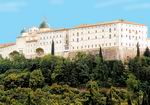 At an altitude of more than 500 m, above the ancient Casinum, the Volscians first and then the Romans had already built some majestic temples devoted to their deities. On the remains of those pagan buildings, in 529, Benedict from Norcia built a small oratory which was to become the mother house of the Benedectine monks and one of the greatest centres for the diffusion of culture in the western world.
At an altitude of more than 500 m, above the ancient Casinum, the Volscians first and then the Romans had already built some majestic temples devoted to their deities. On the remains of those pagan buildings, in 529, Benedict from Norcia built a small oratory which was to become the mother house of the Benedectine monks and one of the greatest centres for the diffusion of culture in the western world.



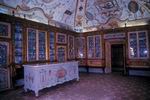

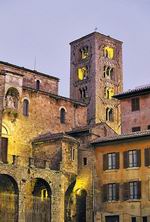
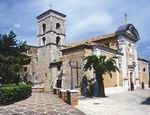
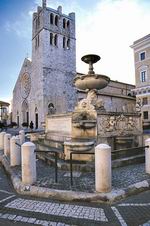 Romanesque art, once enclosed within two lateral panels, where are engraved some episodes of Virgin Mary's and Christ's life, whereas the Trptych of the Saviour, on the right wall, is an original work by the painter Antonio Alatri (15th century), a follower of Gentile da Fabriano.
Romanesque art, once enclosed within two lateral panels, where are engraved some episodes of Virgin Mary's and Christ's life, whereas the Trptych of the Saviour, on the right wall, is an original work by the painter Antonio Alatri (15th century), a follower of Gentile da Fabriano. and made with plain material. The space is divided into three naves by means of 16 columns, all different from one another and coming from pagan buildings. In the main apse there is a marble altar (a gift by Clemente XI, in 1706), where are kept the mortal remains of San Domenico from Foligno who died very old in 1031 after having founded important Benedectine moansteries in Ciociaria.
and made with plain material. The space is divided into three naves by means of 16 columns, all different from one another and coming from pagan buildings. In the main apse there is a marble altar (a gift by Clemente XI, in 1706), where are kept the mortal remains of San Domenico from Foligno who died very old in 1031 after having founded important Benedectine moansteries in Ciociaria.